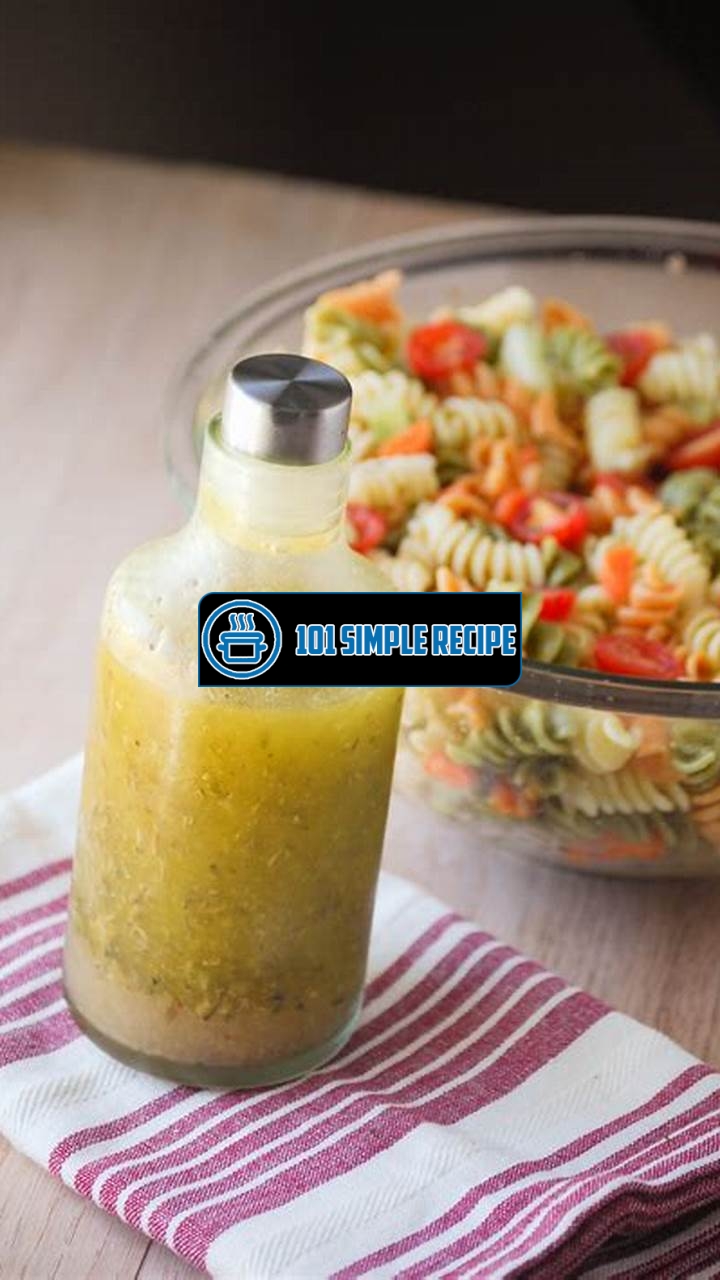Create your own delicious Italian dressing at home and elevate your salad game to new heights! Making your own dressing not only allows you to customize the flavors to your liking, but it also ensures that you know exactly what ingredients are going into it. Say goodbye to store-bought dressings filled with preservatives and hello to a fresh and flavorful dressing made with love. In this article, we will guide you through the process of creating the perfect Italian dressing that will leave your taste buds dancing with joy. So grab your apron and let’s get started!

Understanding DIY Italian Dressing
Discover the ins and outs of making your own delicious and authentic Italian dressing at home. Italian dressing is a versatile and flavorful addition to salads, sandwiches, and marinades. By preparing it yourself, you have full control over the ingredients and can customize it to suit your taste preferences.
History of Italian Dressing
Italian dressing has a fascinating history that dates back to the early 20th century. It originated in the United States and was inspired by Italian immigrants who brought their culinary traditions with them. The dressing was created as a way to capture the flavors of the Mediterranean and provide a tangy and herbaceous dressing for a variety of dishes.
Initially, Italian dressing consisted of olive oil, vinegar, and a blend of dried herbs and spices. Over the years, the recipe has evolved and adapted to include additional ingredients such as garlic, mustard, and sweeteners like honey or sugar. This has allowed for a wide range of variations and flavors to suit different tastes.
The Key Ingredients of Italian Dressing
Italian dressing typically contains a combination of olive oil, vinegar (usually red wine vinegar or white wine vinegar), and a variety of herbs and spices. These can include oregano, basil, thyme, parsley, garlic, onion powder, and black pepper. The dressing may also include a touch of sweetness from sugar, honey, or a sweetener of your choice.
The olive oil is the base of the dressing and provides a rich and smooth texture. It also adds a distinctive flavor that pairs well with the tanginess of the vinegar. The herbs and spices add depth and complexity to the dressing, while the garlic brings a savory and aromatic note.
The Versatility of DIY Italian Dressing
One of the great advantages of making your own Italian dressing is its versatility. It can be used in a variety of ways to enhance the flavor of your favorite dishes. Here are some ideas:
- Salad Dressing: Drizzle the Italian dressing over a crisp green salad for a burst of flavor. It complements both simple and complex salad combinations.
- Marinade: Use the Italian dressing as a marinade for meats, poultry, or vegetables. The acidity of the vinegar helps tenderize the proteins and infuses them with delicious flavors.
- Sandwich Spread: Spread the Italian dressing onto sandwiches, wraps, or burgers to add a zesty kick. It adds moisture and enhances the overall taste of the sandwich.
With DIY Italian dressing, you have the freedom to experiment with different ingredients and ratios to create a dressing that suits your taste preferences. Whether you prefer it tangy, herby, or slightly sweet, the homemade version allows you to customize it to your liking.
In conclusion, making your own Italian dressing at home is a rewarding culinary experience that allows you to savor the flavors of Italy in a convenient and versatile way. With a few simple ingredients and a little creativity, you can create a dressing that elevates your salads, marinades, and sandwiches to a whole new level of deliciousness.
The Benefits of Making DIY Italian Dressing
Explore why creating your own Italian dressing is not only cost-effective but also healthier and tastier.
Economical and Sustainable
Making your own Italian dressing at home offers several benefits, starting with its economic and sustainable nature. By creating the dressing from scratch, you have control over the ingredients and quantities used, allowing you to save money in the long run. Typically, store-bought dressings come in larger quantities than you may need for a single meal, leading to potential waste. When you make your own dressing, you can prepare just the right amount for your needs, reducing food waste and saving money.
Making your own dressing also promotes sustainability as it reduces the demand for packaged products. Store-bought dressings often come in plastic bottles or jars, contributing to plastic waste that harms the environment. By crafting your own dressing, you can use reusable containers and minimize your carbon footprint.
Tip: Consider purchasing ingredients in bulk to further reduce costs and waste. Look for local markets or online suppliers selling items like olive oil, vinegar, and various herbs and spices in larger quantities.
Healthier Alternative to Store-Bought
Another significant advantage of making your own Italian dressing is the ability to control the quality of ingredients used. While store-bought dressings may contain preservatives, artificial flavors, and high levels of sodium and sugar, homemade dressings allow you to choose healthier alternatives.
Making your own dressing gives you the freedom to experiment with different oils, such as extra virgin olive oil or avocado oil, which are packed with heart-healthy monounsaturated fats. You can also play around with various vinegars, like balsamic or apple cider vinegar, which provide beneficial nutrients and acidity to enhance the taste of your dressing.
By making your own dressing, you can also avoid unnecessary additives and artificial ingredients, ensuring a healthier and more nutritious option for your salads and other dishes. Additionally, you have the freedom to adjust the amount of salt and sugar to suit your personal preferences and dietary requirements.
Tip: Don’t be afraid to experiment with different combinations of herbs and spices to enhance the flavor of your dressing. Plus, it’s a great opportunity to use up any herbs or spices you may have in your pantry.
Crafting Your Own Unique Flavor
One of the most exciting aspects of making your own Italian dressing at home is the freedom to express your creativity and develop a unique flavor profile that suits your taste buds. With a wide array of ingredients and flavor enhancers at your disposal, you can create a dressing that perfectly complements your favorite salads, vegetables, or even marinades for meat or fish.
Experimenting with different combinations of herbs, spices, and other ingredients like mustard, garlic, or honey can lead to discovering delightful new flavors that go beyond traditional Italian dressings. By adjusting the proportions according to your preferences, you can achieve the ideal balance of tanginess, sweetness, and richness that enhances any dish.
Tip: Keep a record of the ingredients and proportions you use in your homemade Italian dressing, so you can replicate your favorite creations in the future.
In conclusion, creating your own Italian dressing at home offers a range of benefits, including cost-effectiveness, sustainability, better control over ingredients, and the freedom to develop unique and delicious flavors. So why not give it a try and elevate your salads, appetizers, and main dishes with a personalized touch?
Garlic Italian dressing recipe adds a delicious twist to traditional Italian dressing. The addition of garlic gives it a bold and savory flavor that pairs well with a variety of dishes.
Essential Components of DIY Italian Dressing
When it comes to creating your own delicious Italian dressing at home, understanding the essential components is key. These crucial elements are what make up a classic and authentic Italian dressing recipe, ensuring that you achieve that perfect balance of flavors. Whether you’re preparing a simple side salad or dressing up a hearty pasta dish, knowing these components will help you create a dressing that will elevate any meal.
The Perfect Balance of Oil and Acid
One of the most important aspects of Italian dressing is achieving the perfect balance between oil and acid. The oil provides a smooth and creamy base, while the acid adds a tangy and refreshing element. For a classic Italian dressing, a combination of olive oil and vinegar is typically used. The olive oil brings richness and depth, while vinegar provides the necessary acidity. You can experiment with different types of vinegar, such as red wine vinegar or balsamic vinegar, to add unique flavors to your dressing. Remember to start with a 2:1 ratio of oil to acid and adjust according to your taste preferences.
The Traditional Blend of Herbs and Spices
To give your DIY Italian dressing that authentic flavor, it’s important to include a traditional blend of herbs and spices. Popular choices include dried oregano, basil, garlic powder, and onion powder. These herbs and spices not only add depth and complexity to the dressing but also reflect the traditional Italian flavor profile. Mixing in these aromatic ingredients will enhance the overall taste of your dressing and make it reminiscent of classic Italian cuisine. Don’t forget to crush or grind the dried herbs before adding them to your dressing to release their full flavor.
Secret Ingredients for Extra Depth of Flavor
If you want to take your DIY Italian dressing to the next level, consider adding some secret ingredients for extra depth of flavor. These ingredients will give your dressing a special touch and make it truly memorable. One secret ingredient that can elevate your dressing is a dollop of Dijon mustard. The mustard not only adds a tangy kick but also helps to emulsify the dressing, ensuring that the oil and acid blend together seamlessly. Another secret ingredient to consider is a splash of Worcestershire sauce. This savory sauce adds a hint of umami and complements the other flavors in the dressing perfectly. Finally, for a touch of sweetness, a teaspoon of honey or maple syrup can do wonders. Just a small amount will balance out the tanginess of the vinegar and bring harmony to the overall flavor profile of your dressing.
In conclusion, creating your own delicious Italian dressing at home is a rewarding and simple process. By understanding the essential components of a classic Italian dressing recipe, you can customize it to suit your taste preferences. Remember to achieve the perfect balance of oil and acid, use a traditional blend of herbs and spices, and consider adding secret ingredients for extra depth of flavor. With these tips in mind, you’ll be able to create a dressing that will impress your family and friends and elevate any salad or dish you serve.
DIY Italian dressing recipe is a versatile and flavorful addition to any salad or dish. Whether you’re looking for a simple vinaigrette or a creamy dressing, this recipe has got you covered.
Tips and Tricks for Perfecting DIY Italian Dressing
Creating your own delicious Italian dressing at home is not only a cost-effective choice, but it also allows you to customize the flavors according to your preference. Whether you prefer a tangy or a more herb-forward dressing, these tips and tricks will help you achieve the perfect balance of flavors in your homemade Italian dressing.
Choosing the Right Oils and Vinegars
The choice of oils and vinegars is crucial in creating a flavorful Italian dressing. The traditional combination includes extra-virgin olive oil and red wine vinegar. However, you can experiment with different types of oils and vinegars to add unique flavors to your dressing. For instance, using avocado oil can lend a creamy and rich texture, while balsamic vinegar can add a slightly sweeter taste. Don’t be afraid to mix and match to find your perfect combination.
Tip: Consider using avocado oil for a creamy texture, or balsamic vinegar for a touch of sweetness.
Mastering the Emulsion Process
The key to a well-made Italian dressing lies in the emulsion process. Properly emulsifying the oils and vinegars ensures that the dressing stays mixed and doesn’t separate. To achieve this, start by whisking together the vinegar, mustard, and any other desired seasonings. Slowly add the oil in a steady stream while constantly whisking to create a smooth and creamy texture. This process allows the ingredients to bind together and form a cohesive dressing.
Tip: Whisk the oil into the vinegar mixture gradually to achieve a smooth and creamy texture.
Store and Serve your Italian Dressing Properly
Storage: Once you’ve made your homemade Italian dressing, it’s important to store it properly to maintain its freshness. Transfer the dressing to an airtight container and refrigerate it. This will help preserve its flavors and extend its shelf life.
Serving: When serving your Italian dressing, give it a good shake or whisk to ensure the ingredients are well incorporated. This will also help to redistribute any settled seasonings and herbs. Remember to taste and adjust the seasonings if needed before drizzling it over your favorite salads or dishes.
Tip: ️ Store your Italian dressing in an airtight container in the refrigerator to maintain its freshness.
With these tips and tricks, you can create a delicious Italian dressing right in the comfort of your own kitchen. Experiment with different oils, vinegars, and seasonings to find your own unique twist. Whether you prefer a classic tangy dressing or something with a little more sweetness, homemade Italian dressing is sure to elevate your salads and dishes to new heights!
Exploring Variations of Italian Dressing
Get creative with your homemade Italian dressing by exploring unique twists and regional variations. Italian dressing is a versatile condiment that can be customized to your taste preferences. Whether you like it tangy, creamy, or herb-infused, there are endless possibilities to create your own delicious Italian dressing at home.
Adding Bold Flavors with Garlic and Parmesan
One way to elevate the flavor of your homemade Italian dressing is to add bold ingredients like garlic and Parmesan cheese. These ingredients provide a savory and robust taste that will enhance any salad or dish. Garlic adds a pungent and aromatic element, while Parmesan cheese offers a rich and nutty flavor. You can mince or grate the garlic for a stronger taste, and finely grate the Parmesan cheese to ensure it blends well with the dressing.
If you want to take it a step further, you can also experiment with roasted garlic or Parmesan crisps. Roasted garlic brings a mellow and sweet flavor profile, while Parmesan crisps add a delightful crunch to your dressing. These additions will undoubtedly impress your taste buds.
Creating a Creamier Texture with Yogurt or Mayo
If you prefer a creamy Italian dressing, you can achieve that by incorporating yogurt or mayonnaise into the recipe. These ingredients not only provide a velvety texture but also add a creamy tang to the dressing. Greek yogurt works exceptionally well, as it has a thick consistency and a slightly tart taste. Mayo, on the other hand, offers a creamy and smooth texture. You can adjust the ratio of yogurt or mayo according to your desired creaminess level.
To enhance the creaminess, you can also blend in some sour cream or buttermilk. These additions will add an extra layer of richness and tanginess to your dressing. The creamier texture of the dressing will nicely coat your greens and other salad ingredients, ensuring a delightful bite every time.
Experimenting with Different herbs and Citrus Zest
To infuse your Italian dressing with vibrant flavors, don’t hesitate to experiment with various herbs and citrus zest. Fresh herbs like basil, oregano, parsley, or thyme can elevate the taste profile of your dressing. They add a burst of freshness and aromatic notes that complement the tangy and savory flavors. Citrus zest, such as lemon or orange zest, provides a zingy and refreshing twist that brightens up the dressing.
You can try different combinations of herbs and citrus zest to find your favorite blend. Don’t be afraid to get creative and mix and match flavors. For example, basil and lemon zest create a bright and herbaceous dressing, while oregano and orange zest offer a unique Mediterranean-inspired taste. The possibilities are truly endless when it comes to experimenting with herbs and citrus zest in your Italian dressing.
In conclusion, creating your own delicious Italian dressing at home allows you to explore various flavors and tailor it to your liking. Adding bold flavors such as garlic and Parmesan, creating a creamier texture with yogurt or mayo, and experimenting with different herbs and citrus zest are just some of the ways you can take your homemade dressing to the next level. So, get creative and enjoy the process of crafting your personalized Italian dressing that will elevate any salad or dish. Bon appétit! ️
Italian salad dressing recipe is a staple in many households. It’s a classic dressing that can be used on salads, as a marinade, or as a dip.
Frequently Asked Questions
Here are some frequently asked questions about DIY Italian dressing:
| No. | Questions | Answers |
|---|---|---|
| 1. | How long can I store homemade Italian dressing? | It is recommended to store homemade Italian dressing in an airtight container in the refrigerator for up to 1 week. |
| 2. | Can I use apple cider vinegar instead of red wine vinegar? | Yes, you can substitute apple cider vinegar for red wine vinegar in this recipe. However, it may alter the taste slightly. |
| 3. | Is there a low-fat version of Italian dressing? | Yes, you can make a low-fat version of Italian dressing by using a reduced-fat or fat-free mayonnaise and opting for a light or fat-free Italian dressing mix. |
| 4. | Can I use dried herbs instead of fresh herbs? | Yes, you can use dried herbs instead of fresh herbs in this recipe. However, the flavors may be slightly different. |
| 5. | Is Italian dressing gluten-free? | Italian dressing is typically gluten-free, but it’s always important to check the ingredients and labels to ensure there are no gluten-containing additives. |
| 6. | Can I adjust the amount of garlic in the recipe? | Yes, you can adjust the amount of garlic in the recipe to suit your personal taste. Start with less and add more if desired. |
Thank You for Reading!
We hope you enjoyed learning how to make DIY Italian dressing. With this simple recipe, you can create a flavorful dressing to enhance your salads, pasta dishes, and more. Don’t forget to bookmark this page and visit again later for more delicious recipes and helpful tips. Happy cooking!
Jump to Recipe
DIY Italian Dressing

Learn how to make your own delicious Italian dressing at home with this easy recipe.
- 1/4 cup olive oil
- 2 tablespoons red wine vinegar
- 1 clove garlic (minced)
- 1 teaspoon dried oregano
- 1 teaspoon dried basil
- 1/2 teaspoon salt
- 1/4 teaspoon black pepper
- 1/4 teaspoon sugar
- In a small bowl, whisk together the olive oil, red wine vinegar, minced garlic, dried oregano, dried basil, salt, black pepper, and sugar.
- Taste the dressing and adjust the seasonings to your preference. Add more salt, pepper, or herbs if desired.
- Pour the dressing into a jar or bottle and refrigerate for at least 1 hour before serving.
- Shake the dressing well before each use. Serve over salads, pasta dishes, or as a marinade.
- Store any leftover dressing in an airtight container in the refrigerator for up to 1 week.






